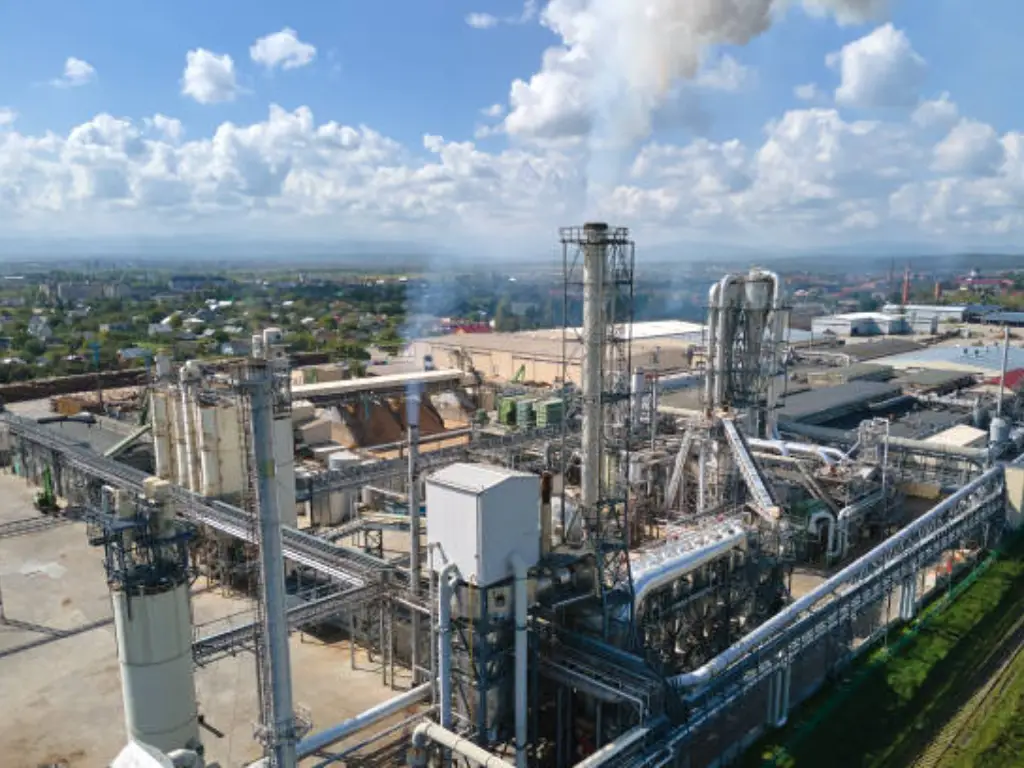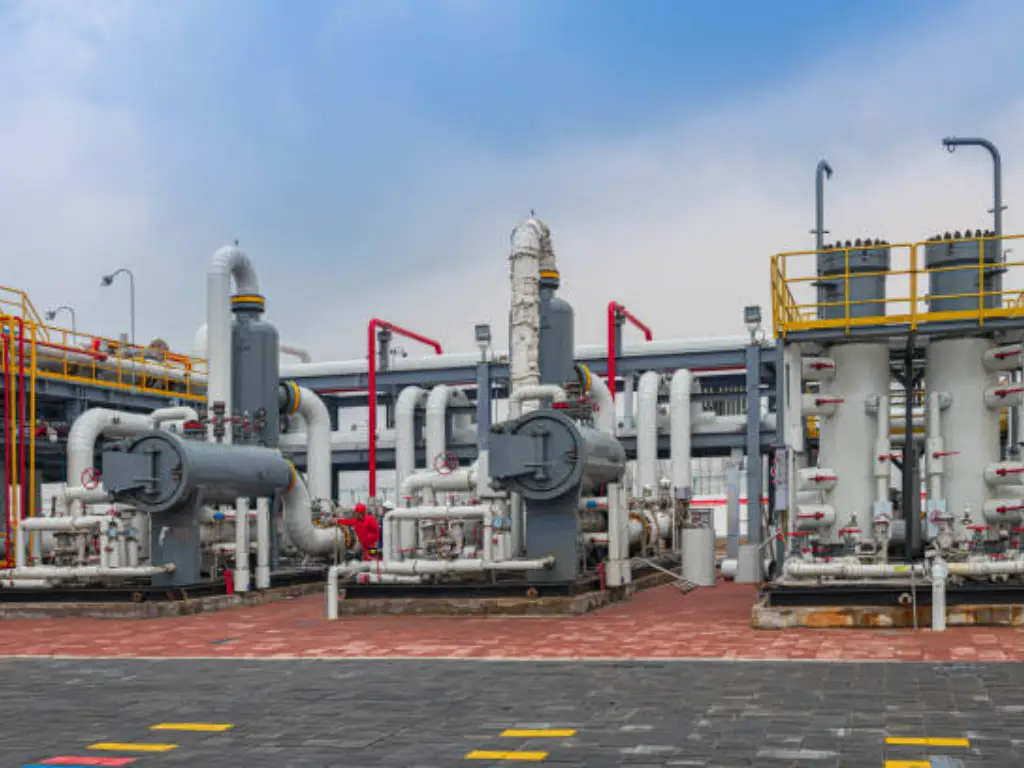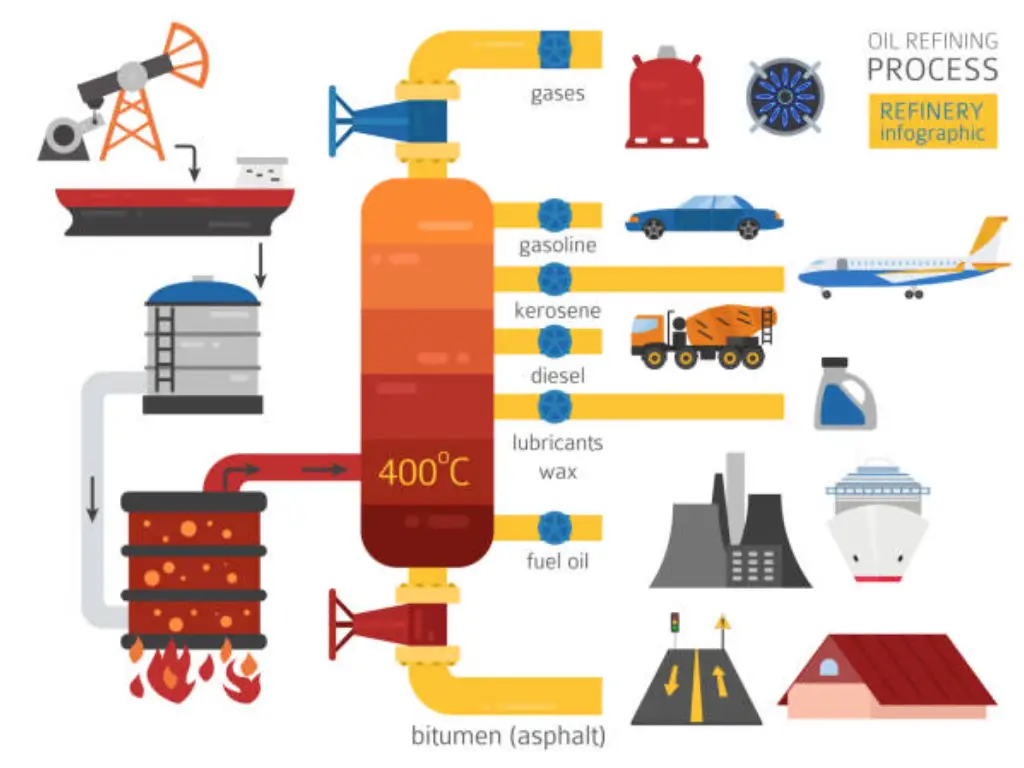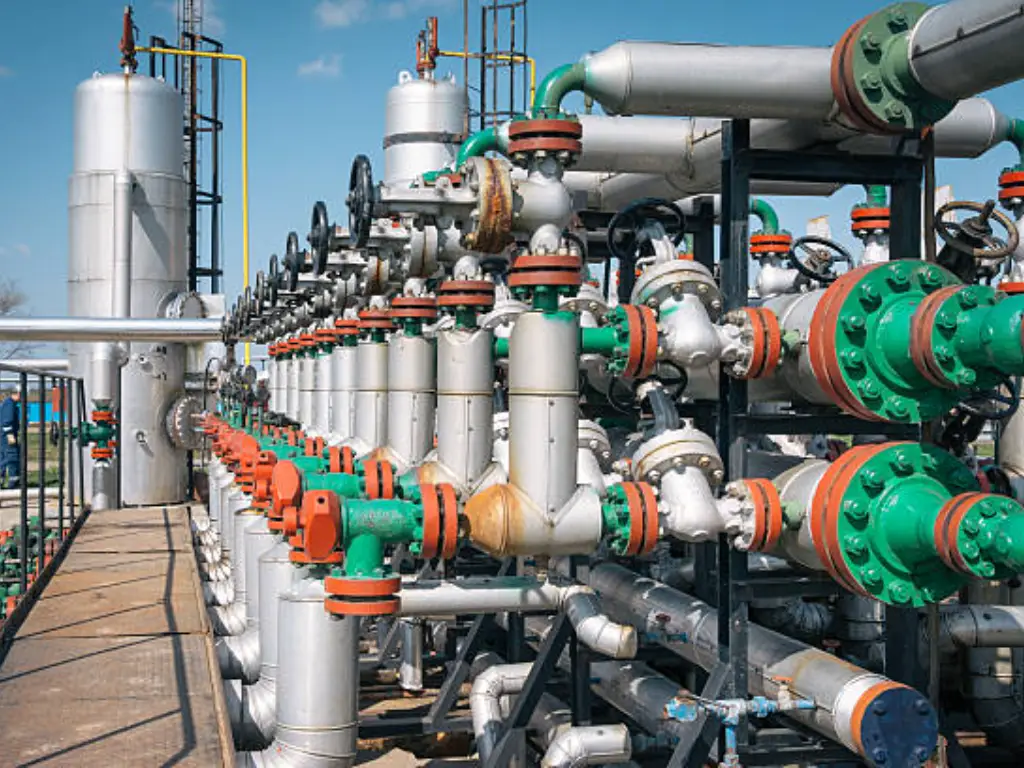
Introduction to Oil Refining
Petroleum refining is an important sub-sector of the petroleum industry, which involves the conversion of crude oil into useful petroleum products. Petroleum in its natural state, that is crude oil as it comes out of the ground, is just the starting point. The oil industry can be divided into three main segments: upstream, midstream, and downstream with the refining process being done in oil refineries.
The refining process is a critical component of the downstream segment of the industry where crude oil is transformed and upgraded into saleable products that are used to power automobiles, heat homes, and fuel numerous other sectors.
The Oil Refining Industry and Its Segments
The oil and gas industry in the United States comprises several segments which are all important in the supply chain. En upstream segment of the industry, which includes the process of crude oil refining, involves exploring for crude oil deposits and the production of crude oil. This segment is made up of specialized petroleum firms that are involved in the extraction of the basic product from the ground. Other support services in this area are drilling contractors and equipment suppliers which are crucial for the functioning of the drilling segment of the industry.
The midstream segment of the industry involves the transportation, storage, and wholesale marketing of crude or refined petroleum products after the extraction of crude oil. Some of the major players in this segment include Magellan Pipeline and ExxonMobil which own large pipeline systems used to transport oil and gas in the country. ExxonMobil is one example of such a firm, while the KinderMorgan pipeline company is an example of a specialized petroleum firm, in this case belonging to the midstream segment.
The downstream segment is mainly involved with the processing of crude oil into products like gasoline, diesel, and other petrochemicals that are marketed to consumers through various outlets. A good example of downstream sales is the WaWa chain of gas stations and convenience stores in eastern Pennsylvania, though large grocery stores and retailers such as Costco and Walmart are also getting more involved in this segment. This segment also contains local gas station brands and the fuel departments of large grocery stores that offer refined petroleum products to the end consumer, including the most visible downstream companies that contribute to the downstream sales of petroleum products, making it one of the most visible and important segments in the oil refining industry.

Why Crude Oil Needs Refining
Crude oil in its natural state is a liquid that is made up of a large number of chemical substances that are predominantly hydrocarbons. While some of the components can be used in their raw form, others require further processing to fit the modern world. The refining process is important because it assists in the creation of useful products from crude oil including gasoline, diesel, jet fuel, and heating oil. This process also involves reforming the chemical nature of hydrocarbons to achieve desired physical properties and increase the market value of those chemicals.
Refining improves the utilization of crude oil in the sense that there is no by-product since all the components of the crude oil are utilized. It also makes it possible to produce high-quality fuels and materials that power our vehicles, heat our homes, and support many industries. If crude oil were not refined, it would not be of much use to the present society as it cannot directly satisfy the high demands and quality that are needed in the present society.
What are the three stages of oil refining?
Stage 1: Separation-The Foundation of Oil Refining
The separation stage is the first process in the refining of crude oil and it entails the fractionation of crude oil based on its properties such as boiling point. This stage is regarded as the initial stage because it fractionates the crude oil into various products that can be reformed for use in cars, homes, and industries among others such as gasoline, diesel, and jet fuel among others.
Crude oil is subjected to a very important separation process in the distillation units and the simplest of them is the atmospheric distillation. In this process, the crude oil is heated to high temperatures, which are between 350°C and 400°C, in a distillation column. When the oil is heated, the oil begins to vaporize and the vapors formed rise through the distillation column. Here the temperature is lowered slowly so that the various fractions can return to liquids at different levels based on their physical properties and boiling points.
In this process, the use of valves is done to control the flow of the liquid and the rate at which the vapors are allowed to rise to get the right separation of the components. These valves are employed to regulate the pressure and temperature of the column to achieve the required separation efficiency.
This separation process is very useful in that it separates the crude oil into various fractions:
Lighter fractions such as gasoline and naphtha condense at higher levels where the temperature is low.
Heavier fractions like diesel fuel and gas oils condense at lower levels where the temperature is still higher.
The heaviest fractions which are the heavy molecules and the residual oils are left at the bottom of the container.
The heaviest fractions which are left after the initial separation by atmospheric distillation require further processing. This is where vacuum distillation comes into play. Vacuum distillation reduces the pressure in the distillation column and therefore the boiling points of these heavy hydrocarbon molecules can be further separated without the use of high temperatures that are likely to affect the quality of the product.

Stage 2: Conversion – Increasing the Value of Crude Oil
Following the separation stage of the oil refining process, the oil refining process enters the conversion stage where several refining processes are used to alter the heavier fractions into lighter and more valuable products. This stage is crucial for enhancing the economic value of crude oil through upgrading the lower-value heavy gas oils into more valuable products such as gasoline, diesel, and jet fuel.
Among the most common methods employed during this stage is the catalytic cracking. Here, heavy gas oils are heated to around 500°C and then exposed to pressure to crack them with the help of a catalyst into lighter molecules. This process optimizes the use of crude oil since it cracks the heavy molecules into lighter products hence enhancing the market value of the end products.
In the processes of catalytic cracking and hydrocracking, valves are used to regulate high pressure and high temperature. They control the flow of reactants into the reactor and the removal of products to enhance reaction rate and safety.
Besides catalytic cracking, hydrogen is incorporated during the conversion stage in a refining process called hydrocracking. In hydrocracking, gas oils are subjected to hydrogen at temperatures of between 300°C and 400°C. This process not only continues to fractionate the molecules but also purges the fuel of impurities such as sulfur thus improving the quality of the fuel. The products that are produced through hydrocracking contain aromatic hydrocarbons with a sulfur content of as low as 10 ppm which complies with the environmental standards and thus the end products are cleaner and more efficient.
Stage 3: Treatment – Ensuring Quality and Medio ambiente Conformidad
The last step in the refining process is the treatment where the emphasis is on purification and quality improvement of the final products like heating oil, diesel fuel, and jet fuel to meet the environmental and market standards. This stage is important in as much as it guarantees that the final transportation fuels are both eco-friendly and suitable for use in engines.
One of the major goals in the treatment stage is the removal of sulfur since it causes pollution of the environment and also affects the engines. Hydrodesulfurization is the most common technique, in which hydrogen reacts with sulfur at temperatures of 300-400°C and forms hydrogen sulfide that can be eliminated. This process also helps in minimizing the sulfur content in the saleable products to less than 10 ppm thus meeting the environmental standards.
During the treatment phase, the valves are employed to regulate the flow of hydrogen and other treatment gases to achieve the best results of chemical reactions and improve the efficiency of the impurities removal process.

Apart from sulfur removal, the treatment also includes a catalytic reforming process to enhance the octane rating of gasoline. This step helps the fuel to burn properly in the modern engines thus eliminating the chances of knocking. Additional purification steps, including sweetening, eliminate other contaminants, including nitrogen compounds and metals, to guarantee that the final product is chemically clean and does not degrade during storage and transportation.
After the treatment process is over, the products are in the right form to be marketed in the market. These saleable products are then sold to gasoline stations and other outlets for the retail sale of petroleum products which in turn satisfies the various needs of consumers and industries across the world. The treatment stage not only adds value to these chemicals in the market but also makes sure that these finished products meet international environmental standards, which makes the treatment stage a very important last stage of converting crude oil into finished products.
Valve Requirements at Each Stage of Oil Refining
The requirements for the valves in the process of oil refining are quite different depending on the stage of the process. These include pressure, temperature, material, and sealing performance, and each of these stages poses different technical challenges to valves.
| Refining Stage | Pressure Requirements | Temperature Requirements | Material Requirements | Sealing Performance Requirements |
| Separation Stage | Medium pressure (typically 1-5 MPa) | High temperature (300-400°C) | Corrosion-resistant stainless steel or alloys | Good sealing performance at high temperatures to prevent leaks |
| Conversion Stage | High pressure (up to 20 MPa or more) | Extremely high temperature (500°C+) | Special alloys (e.g., nickel-based alloys) for high temperature and corrosion resistance | Excellent sealing performance to prevent particle blockage or seal failure |
| Treatment Stage | Low to medium pressure (1-10 MPa) | Medium temperature (200-350°C) | High alloy stainless steel, corrosion-resistant | Good sealing to ensure product purity |
Products Resulting from Oil Refining
The refining process results in the generation of many valuable products some of which are as follows:
- Petrol – This is mainly used as fuel for automobiles, especially cars.
- Diesel – This is used in trucks, buses, and industrial engines.
- Jet Fuel – This is a type of fuel that is used in aviation.
- Heating Oil – This is used for heating of buildings.
- Liquefied Petroleum Gas (LPG) – This is used in homes for heating, cooking, and automobiles.
- Petrochemical Feedstocks – These are products that are used in the production of plastics, chemicals, and synthetic products.
- Kerosene – Used for heating and jet engines.
- Asphalt – It is used in the construction of roads.
- Lubricants – These are products that are used in the reduction of friction in engines and other related equipment.
- Sulfur – Used in fertilizers and chemicals.
Conclusión
Thus, it is possible to conclude that the three principal stages of the oil refining process are separation, conversion, and treatment. All these stages are important in the process of refining crude oil into several products, including those that power our cars, heat our homes, and are used in several industries.
The separation stage involves the process of fractionation of crude oil into its components, the conversion stage involves the enhancement of the value of these components through the production of better products and the treatment stage involves the purification of the final products to meet the required quality and environmental standards.
The future of the oil refining industry will be shaped by the advancement in technology and an increase in efficiency and environmental regulation. However, the processing of crude oil remains one of the most important segments of the global energy supply and will remain a vital cog in the wheel in the satisfaction of the world’s energy needs in terms of quality and quantity.
Amplify Refining Operations with DomBor Valve Solutions
Valves are indispensable in refining and petrochemical industries and the proper valve can make a difference in challenging environments. DomBor Valve offers its customers valves that are safe, efficient, and reliable to meet the customers’ needs. Our valves are suitable for corrosive services and severe service environments and they are made according to ISO15848 and SHELL 77/312. Whether you need shut off, isolation, measurement, control, or protection of fluids in pipelines, DomBor Valve offers the performance you can trust. Find out how our durable, certified products can enhance your refining processes. Contact Our Team of Professionals Now!









